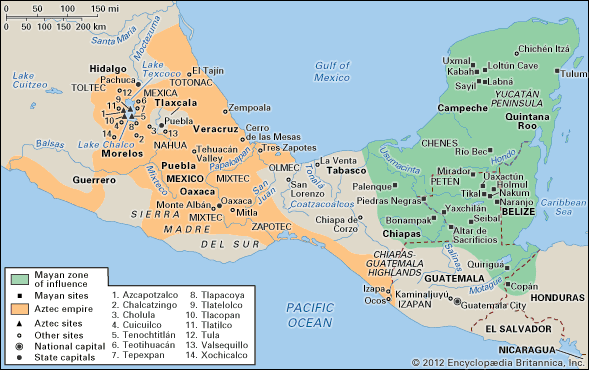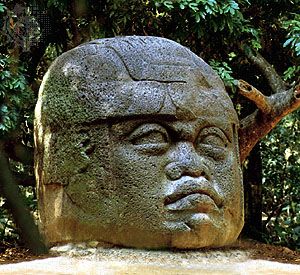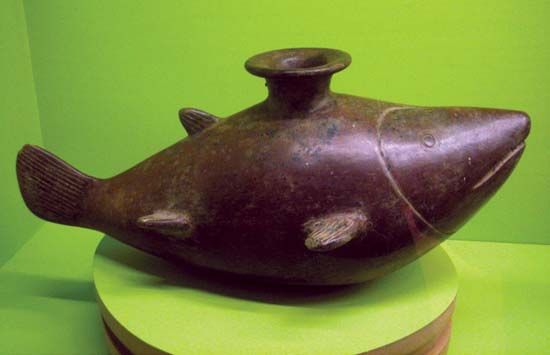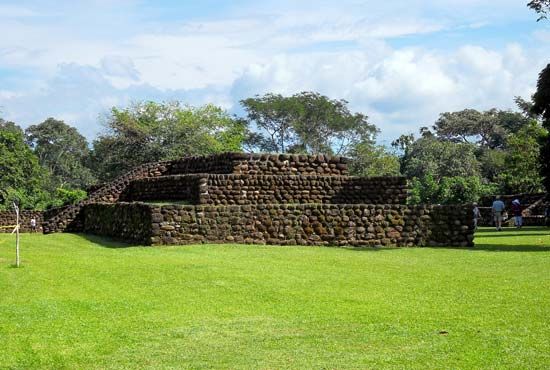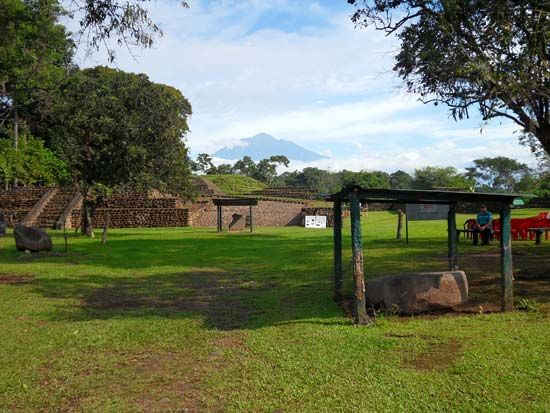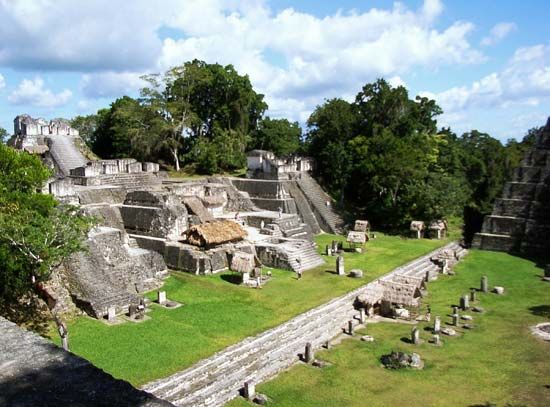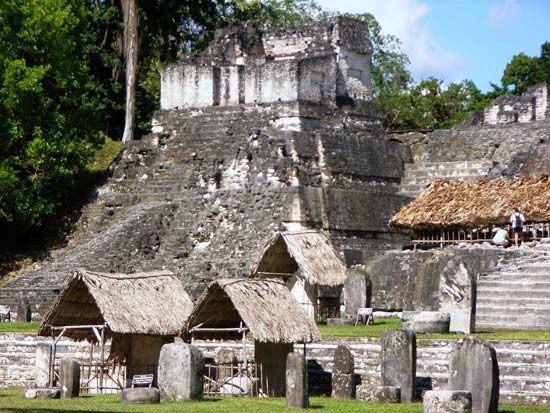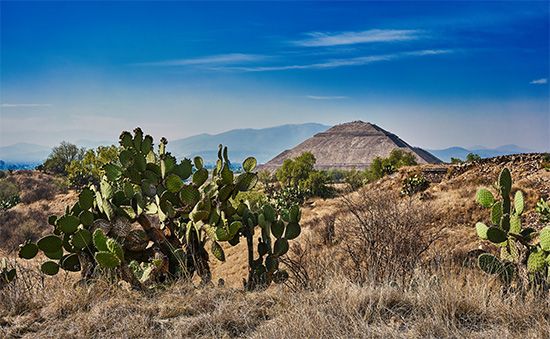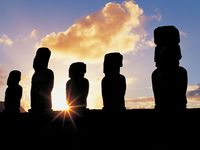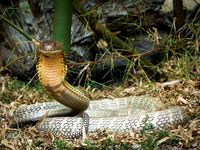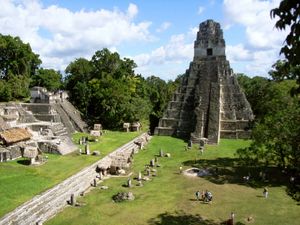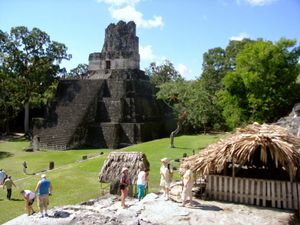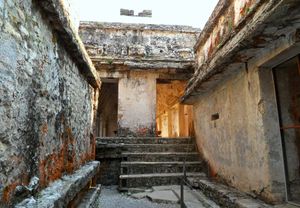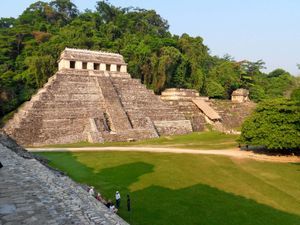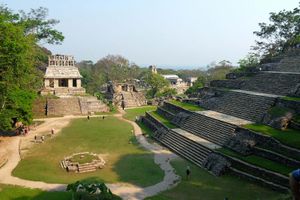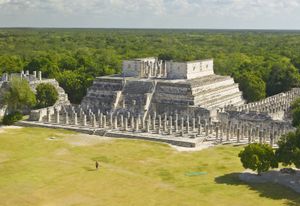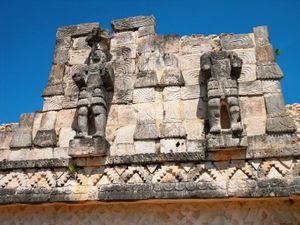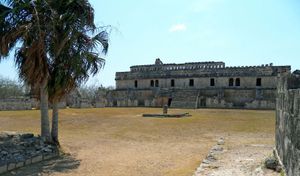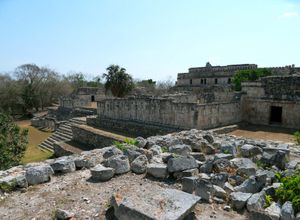Late Classic Lowland Maya (600–900)
Settlement pattern
There is still controversy over whether the Late Classic sites built by the lowland Maya were actually cities or whether they were relatively empty ceremonial centres staffed only by rulers and their entourages. The common people built their simple pole-and-thatch dwellings on low earthen mounds to keep them dry during the summer rains. Thus, total mapping of a particular site should always include not only masonry structures but house mounds as well. Several Maya sites have been so mapped. The mightiest Maya centre of all, Tikal in northern Petén, has a total of about 3,000 structures ranging from the tiny mounds up to gigantic temple pyramids; these are contained, however, within an area of six square miles. The Tikal population has been estimated from this survey to be 10,000–11,000 people, but perhaps as many as 75,000 within an even wider area could have belonged to Tikal.
This sounds very much like a city, but the evidence actually can be differently interpreted. First, at the time of the conquest the Maya generally buried their dead beneath the floors of houses, which were then abandoned. Thus, an increase in number of house mounds could just as easily indicate a declining population in which the death rate exceeded the birth rate. Second, the appearance of even such a tremendous centre as Tikal is quite different from that of such true cities as Teotihuacán. An ordinary Maya family typically occupied two or three houses arranged around a rectangular open space. These were grouped into unplanned hamlets near good water and rich, well-drained soils. A survey of Petén has shown that for every 50 to 100 dwellings there was a minor ceremonial centre; this unit has been called a zone. Several zones formed a district for which a major centre like Tikal acted as the ceremonial and political nucleus. Neither Tikal nor any other such centre shows signs of town planning or neatly laid out streets.
There are also ecological factors that must have set certain limits upon the potential for urban life in the Maya lowlands. Slash-and-burn cultivation would have made for widely settled populations; and, as has been argued, the uniformity of the lowland Maya environment would have worked against the growth of strong interregional trade, always a factor in urban development. Yet these statements must be qualified. It is known that raised-field, or chinampa-type, farming was used in many places and at many times in the Maya lowlands. This would have allowed for greater population concentration. It is also known that there was a brisk trade in some commodities from one lowland Maya region to another.
What, then, can be concluded about lowland Maya urbanism? Clearly, the urban form, even at a metropolis such as Tikal, was not as large or as formally developed as it was at highland Teotihuacán. At the same time, a centre whose rulers could draw upon the coordinated efforts of 75,000 people must inevitably have had some of the functions of a true city—in governance, religion, and trade, as well as in the development of the arts and intellectual life.
Major sites
While there are some important differences between the architecture of the Central and Northern subregions during the Late Classic, there are many features shared between them. A major Maya site generally includes several types of masonry buildings, usually constructed by facing a cement-and-rubble core with blocks or thin slabs of limestone. Temple pyramids are the most impressive, rising in a series of great platforms to the temple superstructure above the forests. The rooms, coated with white stucco, are often little more than narrow slots because of the confining nature of the corbeled vaults, but this was probably intentional, to keep esoteric ceremonies from the public.
The so-called palaces of Maya sites differ only from the temple pyramids in that they are lower and contain a great many rooms. Their purpose still eludes discovery; many scholars doubt that they really served as palaces, for the rooms are damp and uncomfortable, and there is little or no evidence of permanent occupation. The temples and palaces are generally arranged around courts, often with inscribed stelae and altars arranged in rows before them. Leading from the central plazas are great stone causeways, the function of which was probably largely ceremonial. Other features of lowland sites (but not universal) are sweathouses, ball courts, and probably marketplaces.
There are more than 50 known sites that deserve to be called major. Most are in the Central Subregion, with probably the greatest concentration in northern Petén, where Maya civilization had its deepest roots. Tikal is the largest and best-known Classic site of the Central Subregion. It is dominated by six lofty temple pyramids, one of which is some 230 feet (70 metres) high, the tallest structure ever raised by the Mesoamerican Indians. Lintels of sapodilla wood still span the doorways of the temple superstructures and are carved with reliefs of Maya lords enthroned amid scenes of great splendour. Some extraordinary Late Classic tombs have been discovered at Tikal, the most important of which produced a collection of bone tubes and strips delicately incised with scenes of gods and men. Ten large reservoirs, partly or entirely artificial, supplied the scarce drinking water for the residents of Tikal.
Other important sites of northern Petén include Uaxactún, Naranjo, Nakum, and Holmul. To the southeast of Petén are two Maya centres—Copán and Quiriguá—that show notable differences with the Petén sites. Copán is located above a tributary of the Motagua River in western Honduras in a region now rich in tobacco. Its architects and sculptors had a ready supply of a greenish volcanic tuff far superior to the Petén limestone. Thus, Copán architecture is embellished with gloriously baroque figures of gods, and its stelae and other monuments are carved with an extraordinary virtuosity. Copán also has one of the most perfectly preserved ball courts in Mesoamerica. Quiriguá is a much smaller site 30 miles north of Copán. While its architectural remains are on a minor scale, it is noted for its gigantic stelae and altars carved from sandstone.
The principal watercourse on the western side of the Central Subregion is the Usumacinta River, originating in the Guatemalan highlands and emptying into the Gulf of Mexico. For much of its course the Usumacinta is lined with such great Maya ceremonial centres as Piedras Negras and Yaxchilán. Even more renowned is Bonampak, a satellite of Yaxchilán located on a tributary of the Usumacinta. The discovery in 1946 of the magnificent murals embellishing the rooms of an otherwise modest structure astounded the archaeological world. From floors to vault capstones, its stuccoed walls were covered with highly realistic polychrome scenes of a jungle battle, the arraignment of prisoners, and victory ceremonies. These shed an entirely new light on the nature of Maya society, which up until then had been considered peaceful.
In the hills just above the floodplain of the Usumacinta lies Palenque, usually considered to be the most beautiful of Maya sites. The architects of Palenque designed graceful temple pyramids and “palaces” with mansard-type roofs, embellished with delicate stucco reliefs of rulers, gods, and ceremonies. The principal structure is the Palace, a veritable labyrinth of galleries with interior courts; over it looms a four-story square tower that may have served as both lookout and observatory. A small stream flowing through the site was carried underneath the Palace by a long, corbel-vaulted tunnel. The temples of the Cross, Foliated Cross, and Sun were all built on the same plan, the back room of each temple having a kind of sanctuary designed like the temple of which it was a part. It can be supposed that all three temples served the same cult. The most extraordinary feature of Palenque, however, was the great funerary crypt discovered in 1952 deep within the Temple of the Inscriptions. Within a sarcophagus in the crypt were the remains of an unusually tall ruler, accompanied by the richest offering of jade ever seen in a Maya tomb. Over his face had been fitted a mask of jade mosaic, while a treasure trove of jade adorned his body.
Northward from the Central Subregion, in the drier and flatter environment of the Yucatán Peninsula, the character of lowland Maya civilization changes. Just north of Petén is the Río Bec zone, as yet little explored but noted for temple pyramids and palaces with flanking false towers fronted by unclimbable “stairways” reaching dummy “rooms” with blank entrances. Río Bec structures are carved with fantastic serpents in deep relief, a feature that becomes even more pronounced in the Chenes country to the northwest, in the modern state of Campeche. At Chenes sites, Maya architects constructed frontal portals surrounded by the jaws of sky serpents and faced entire buildings with a riot of baroquely carved grotesques and spirals.
This elaborate ornamentation of buildings is far more restrained and orderly in the style called Puuc, so named from a string of low hills extending up from western Campeche into the state of Yucatán. The Puuc sites were for the Northern Subregion what the Petén sites were for the Central, for they are very numerous and clearly were the focal point for Maya artistic and intellectual culture. Uxmal is the most important Puuc ceremonial centre and an architectural masterpiece. It has all of the characteristics of the Puuc style: facings of thin squares of limestone veneer over a cement-and-rubble core; boot-shaped vault stones; decorated cornices around columns in doorways; engaged or half-columns repeated in long rows; and lavish use of stone mosaics in upper facades, emphasizing sky-serpent faces with long, hook-shaped noses, as well as frets and latticelike designs of crisscrossed elements.
The nearby centre of Kabah, connected to Uxmal by a ceremonial causeway, has an extraordinary palace completely faced with masks of the Sky Serpent. Other major Puuc sites are Sayil, with a multistoried palace, and Labná. The Puuc style reaches east across the Yucatán Peninsula, for at Chichén Itzá, a great site that was to occupy centre stage during the Toltec occupation of the Northern Subregion, there are several buildings strongly Puuc in character.
Puuc sites may be said to represent a lowland Maya “New Empire” in the sense that their apogee occurred in the 9th and 10th centuries, a time during which the great Petén, or Central Subregion, centres were in decline or had collapsed. Just how late Puuc sites remained active, with major constructions being dedicated, remains something of a question. About 1000 a major change took place in northern Yucatán. It was marked by the construction of a number of Toltec-style temples and palaces at Chichén Itzá, a site that also has many Puuc-style edifices. It is not known if Toltec Chichén Itzá existed contemporaneously with such Puuc sites as Uxmal and Labná, and if so, for how long. Eventually, Chichén Itzá appears to have dominated northern Yucatán, lasting well into the Postclassic Period (about 1250). Questions also surround the bringers of Toltec-style architecture to Chichén Itzá. They may have been either central Mexican Toltecs or Gulf coast peoples who probably were Maya-speakers and who had adopted central-Mexican ways. In this connection, it should be noted that Puuc sites were under several influences from Gulf-coast Mexico, particularly from central Veracruz.
Maya art of the Late Classic
Maya art, at the height of its development, was fundamentally unlike any other in Mesoamerica, for it was highly narrative, baroque, and often extremely cluttered, unlike the more austere styles found elsewhere. It is essentially a painterly rather than sculptural tradition, and it is quite likely that even stone reliefs were first designed by painters. Much of this art has disappeared for all time because of the ravages of the wet, tropical environment on such perishable materials as wood, painted gourds, feathers, bark, and other substances. There must have been thousands of bark-paper codices, not one of which has survived from Classic times.
Following the downfall of Teotihuacán, Maya artists were free to go their own way. Magnificently carved stelae and accompanying altars are found at most major sites, the greatest achievement in this line being found at Copán, where something approaching three-dimensional carving was the rule. Palenque and Yaxchilán specialized in graceful bas-reliefs placed as tablets or lintels in temple pyramids and palaces. In the Northern Subregion, however, the sculptor’s art was definitely inferior in scope and quality and shows strong influence from alien, non-Maya cultures.
A few wooden objects have somehow survived. Particularly noteworthy are the massive wooden lintels of Tikal, with scenes of lords and their guardian deities, accompanied by lengthy hieroglyphic texts. In ancient times, wood carvings must have been vastly more common than sculptures. The wet climate has also destroyed innumerable examples of mural art.
Maya pottery can be divided into two groups: (1) the pots and pans of everyday life, usually undecorated but sometimes with geometric designs, and (2) grave offerings. Vessels meant to accompany the honoured dead were usually painted or carved with naturalistic and often macabre scenes. To achieve polychrome effects of great brilliance, the Maya potters painted in semitranslucent slips over a light background, then fired the vessels at a very low temperature. Relief carving was carried out when the vessels were leather-hard, just before firing.
The most precious substance of all to the Maya was jade, to which their craftsmen devoted great artistry. Jade was mainly fashioned into thin plaques, carved in relief, or into beads. In the absence of metal tools, jade was worked by applying abrasives and water with cane or perhaps other pieces of jade.

